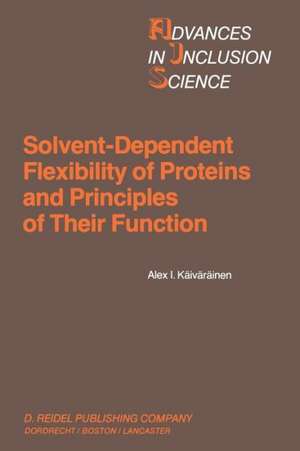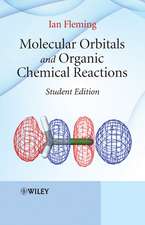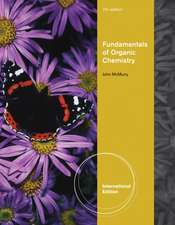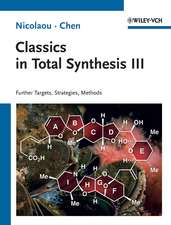Solvent-Dependent Flexibility of Proteins and Principles of Their Function: Advances in Inclusion Science, cartea 2
Autor Alex I. Käiväräinenen Limba Engleză Paperback – 13 oct 2011
Preț: 388.90 lei
Nou
Puncte Express: 583
Preț estimativ în valută:
74.45€ • 77.68$ • 62.41£
74.45€ • 77.68$ • 62.41£
Carte tipărită la comandă
Livrare economică 12-26 martie
Preluare comenzi: 021 569.72.76
Specificații
ISBN-13: 9789401087988
ISBN-10: 9401087989
Pagini: 308
Ilustrații: 350 p.
Dimensiuni: 155 x 235 x 16 mm
Greutate: 0.44 kg
Ediția:Softcover reprint of the original 1st ed. 1985
Editura: SPRINGER NETHERLANDS
Colecția Springer
Seria Advances in Inclusion Science
Locul publicării:Dordrecht, Netherlands
ISBN-10: 9401087989
Pagini: 308
Ilustrații: 350 p.
Dimensiuni: 155 x 235 x 16 mm
Greutate: 0.44 kg
Ediția:Softcover reprint of the original 1st ed. 1985
Editura: SPRINGER NETHERLANDS
Colecția Springer
Seria Advances in Inclusion Science
Locul publicării:Dordrecht, Netherlands
Public țintă
ResearchCuprins
1 / The Properties of Water.- 1.1. Pure Water.- 1.2. Water in Model Systems.- 2 / Principles and Implications of the Dynamic Model of Behavior of Proteins in Aqueous Media.- 2.1. Description of the Properties of Proteins in Terms of the Dynamic Model.- 2.2. A Description of the Properties of Membranes in Terms of the Dynamic Model.- 3 / Conformational Mobility of Proteins.- 3.1. Studying Hydrated Biopolymers by IR Spectroscopy.- 3.2. Fundamental Principles of Hydrogen Exchange Method.- 3.3. Results Obtained by Hydrogen Exchange and Proteolytic Studies.- 3.4. Fundamental Principles and Applications of the NMR Method.- 3.5. Gamma-Resonance Spectroscopy and its Applications.- 3.6. The Method of Spin Label and its Application.- 3.7. Application of Luminescence to the Study of Protein Dynamics.- 3.8. Results of X-Ray Diffraction Studies of Protein Mobility.- 4 / Interaction Between Proteins and Water.- 4.1. Hydration of Biopolymers and Methods of its Study.- 4.2. Protein Cavities (Clefts) and their Interaction with Water.- 4.3. The Dynamics of Water-Protein Interaction.- 5 / Effect of Perturbing Agents on the Dynamic Properties of Proteins.- 5.1. Changes in the Conformation and Stability of Proteins Brought about by Perturbing Agents.- 5.2. Effect of Temperature on Protein Dynamics and on the Interaction between the Protein and the Surrounding Solvent.- 5.3. Ultrasonic Action.- 6 / Dynamic Model of Association and Dissociation of Specific Complexes.- 6.1. Effect of Complex Formation on the Stability of the Protein.- 6.2. Effect of Complex Formation on Dynamic Properties of Proteins.- 6.3. Immunoglobulins.- 6.4. Cytochrome c.- 6.5. Myoglobulin.- 6.6. Hemoglobin.- 7 / Dynamic Model of Protein Behavior and Mechanism of Enzymatic Function.- 7.1. A Possible Connection between theKinetic and Conformational Properties of Enzymes.- 7.2. Comparison between the Dynamic Model of Enzymatic Activity and Other Models of Enzymatic Catalysis.- 7.3. Relaxational Properties of Enzymes.- 7.4. Effect of Perturbing Agents on Enzymatic Activity.- 7.5. Action of D2 O on Enzymes.- 7.6. Glyceraldehyde-3-Phosphate Dehydrogenase.- 7.7. Transaminase.- 7.8. Myosin.- 7.9. Lysozyme.- 7.10. ?-Chymotrypsin and Pepsin.- 7.11. Study of Reactions Involving Papain at Low Temperature.- 7.12. Allosteric Enzymes.- 8 / Interactions between Macromolecules of Different Types and Proteins and Cells in Aqueous Media.- 8.1. Effect of Polymers on the Flexibility of Antibodies in Complex with Spin-labeled Hapten at Different Temperatures.- 8.2. Effect of Proteins on the Flexibility of Antibodies and Oxyhemoglobin.- 8.3. Effect of Thermality Induced Transitions of Human Serum Albumin on the Mobility of the Subunits of Spin-labeled Oxyhemoglobin.- 8.4. Effect of Polymers and Proteins in Different Ligand States of Active Sites on the Properties of the Solvent.- 8.5. Interaction between Serum Proteins and Cells.- Conclusion.- References.- Index of Authors.- Index of Subjects.
Recenzii
`This work will prove to be useful to all workers involved in advanced studies on protein interactions, enzymatic reactions and protein purification. It is recommended to all protein chemists, immunochemists and molecular biologists.'
Preparative Biochemistry (1985)
Preparative Biochemistry (1985)
















